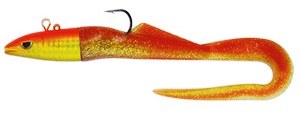

After about a year, the moray eel larvae are big enough to swim down to the ocean floor and hide in rocks and crevices.

These eggs are fertilized by the sperm of male eels and become part of the plankton as larvae, fighting to survive in the open ocean. On average, female moray eels can release 10,000 eggs at a time. Moray eels reproduce by fertilization that is oviparous, when eggs and sperm are fertilized in the water outside the womb, also known as spawning. Moray eels hide out in the crevices of reefs or wrecks, swimming out only to catch their prey or if they feel their space has been invaded. Most moray eels are found in seawater, but some can be found in brackish water or even freshwater.

Moray eels can be found worldwide but are most commonly found in tropical and temperate waters. An interesting fact about the green moray eel is that is actually brown! The mucus covering its body is what gives the green moray eel a green-like appearance. Some moray eels, such as the banded moray eel, can even change their colors to better camouflage.

All these colors can appear as stripes, spots, or some other pattern on the eel. They can be black, gray, brown, yellow, green, blue, orange, or white. A night dive in warm, shallow water will often allow you to witness the beauty of moray eels out swimming on the reef. Moray eels are nocturnal, thus good eyesight is not a necessity for these creatures. The large nostrils also aid in sensing what is around them. They rely on chemoreception, a physiological response to chemical stimuli, to catch their food. The mucus is secreted by goblet cells and acts a protective barrier against abrasions from hiding out in the rocks. The body of moray eels is covered in a mucus layer, and in some species, this mucus is toxic. Even though moray eels appear to be smooth, they do have fins! They have a dorsal fin that connects all the way to the caudal and anal fins giving the eels a mohawk appearance. These snake-like creatures belong to the Class Actinopterygii, the ray-finned fishes. Moray eels are known for their slithering snake-like appearance, but they spend most of their time hiding in rocks and crevices. The snowflake moray and zebra moray eels are the two most popular choices of species to keep in an aquarium.
#Wolf eel angry full#
On the other hand, if you are lucky, you may even see an eel out swimming on the reef! While moray eels are truly interesting creatures that many divers wish to encounter, it can be terrifying to some divers that may have had the chance encounter of an eel lunging at them! Be aware of your surroundings and keep your hands off the reef or you might get a mouth full of eel on your hand! Overall, moray eels are beautiful, colorful, creatures that should have their space respected.ĭespite the common use of moray eel as a specific type of eel, it is actually a family of eels that includes about 200 species. When on a dive, it becomes a sort of treasure hunt, looking into all the cracks and crevices to get that glimpse of an eel. Would you believe moray eels are actually fish? Moray eels are such interesting creatures that are often a highlight of a scuba diving adventure.


 0 kommentar(er)
0 kommentar(er)
